![]()
![]()
![]()
Use LEFT and RIGHT arrow keys to navigate between flashcards;
Use UP and DOWN arrow keys to flip the card;
H to show hint;
A reads text to speech;
32 Cards in this Set
- Front
- Back
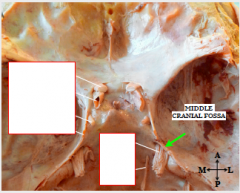
ID the nerves and vessels shown here.
Which CN is the internal carotid inferior to? |
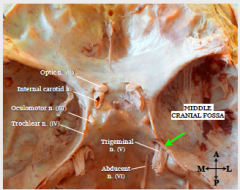
The internal carotid is directly inferior to the Optic n. (CN II). |
|
|
What are the 3 branches of the Trigeminal n (CN V)?
Where do they exit? "Standing Room Only" |
Branches CN V1: Opthalmic - Superior orbital fissure CN V2: Maxillary - Foramen rotundum CN V3: Mandibular - Foramen ovale |
|
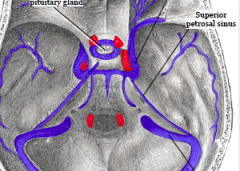
ID the cavernous sinus.
Name the nerves and vessels that pass through. |
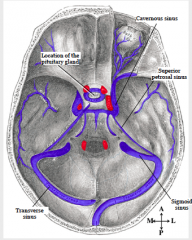
Cavernous sinus is located lateral to sella turcica (where pituitary gland sits), in middle cranial fossa.
Contains: Eye nerves and internal carotid a.
- 1st 2 branches of CN V *CN V1 (Opthalmic) *CN V2 (Maxillary)
- CN III (Oculomotor)
- CN IV (Trochlear)
- CN VI (Abducens)
- Internal carotid a.
|
|
|
What are the four parts of the internal carotid artery?
Which one branches?
Which one is directly inferior to the Oculomotor n. (CN III)? |
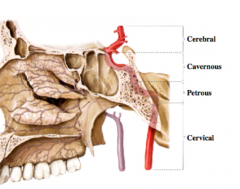
Only the cerebral part of the Int. Carotid a. branches.
Cavernous part is directly inferior to CN III. Both are in the cavernous sinus. |
|
|
Describe the branching pattern of CN V1 (Opthalmic) to the superior orbit.
Which arteries follow its branches? |
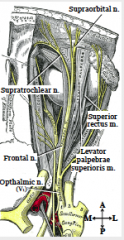
1. Opthalmic n (CN V1) exits Superior orbital fissure.
2. CN V1 -> Frontal n.
3. Frontal n. -> 2 parts -> Supratrochlear (medial)
-> Supra-orbital (lateral)
NEED TO DO ARTERIES.
|
|
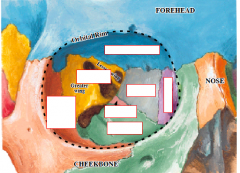
ID the bones that form the orbit (eye socket).
What are the boundaries? |
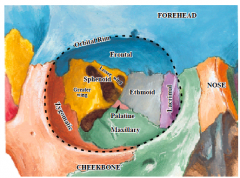
Boundaries
Roof – frontal
Floor – maxillary, zygomatic
Medial wall – ethmoid, lacrimal
Lateral wall – zygomatic
Apex – sphenoid
|
|
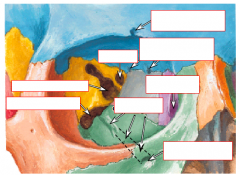
ID the features of the eye. |
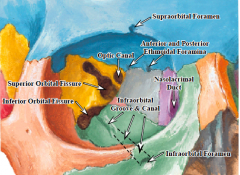
1) Supraorbital foramen - above the rim of orbit
2) (Lat -> med) Ant, posterior ethmoid foramina - Border of frontal and ethmoid
3) Nasolacrimal duct
- Lacrimal -> nasal
*Move laterally; sphenoid region
4) Optic canal - Sphenoid - Exit site for CN II
5) Superior orbital fissure - Sphenoid -> ethmoid, palatine
6) Inferior orbital fissure - Sphenoid -> maxillary
*Inf orbital fissure goes postero-med to maxillary to make:
7) Infraorbital groove and canal - Maxillary
*Infraorbital groove and canal end in...
8) Infraorbital foramen *Post edge of orbit - Maxillary
|
|
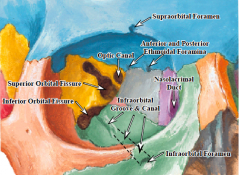
Which bones make up these features? |
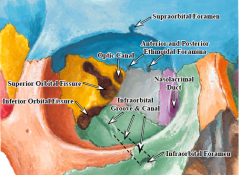
1) Supraorbital foramen - above the rim of orbit
2) (Lat -> med) Ant, posterior ethmoid foramina - Border of frontal and ethmoid
3) Nasolacrimal duct
- Lacrimal -> nasal
*Move laterally; sphenoid region
4) Optic canal - Sphenoid - Exit site for CN II
5) Superior orbital fissure - Sphenoid -> ethmoid, palatine
6) Inferior orbital fissure - Sphenoid -> maxillary
*Inf orbital fissure goes postero-med to maxillary to make:
7) Infraorbital groove and canal - Maxillary
*Infraorbital groove and canal end in...
8) Infraorbital foramen *Post edge of orbit - Maxillary |
|
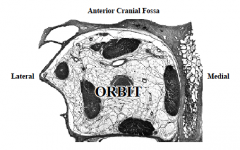
What are the contents of the orbit? |
Fat
Eyeball
Muscles a. Extraocular - extrinsic, move eye(ball) b. Intraocular - intrinsic, ctrl lens and pupil
Opthalmic artery *Branch of Internal carotid a.
Superior, inferior opthalmic veins
CNs: II (Optic) III (Oculomotor) IV (Trochlear) V (Trigeminal) - V1 (Opthalmic) and V2 (Maxillary) branches only VI (Abducens)
|
|
|
What are the CNs going to the orbit?
How do they reach the orbit?
Which CN branches further? Name its 3 major branches. How do they relate (e.g. sup./inf.)to each other?
|
CNs to orbit CN II - Optic CN III - Oculomotor CN IV - Trochlear CN V - Trigeminal - V1 (Opthalmic), V2 (Maxillary) CN VI - Abducens
*CN II goes thru optic canal to reach orbit All others go through Superior orbital fissure
CN V1 branches more, near sup. orbital fissure: "LFN"
*Superficial Lacrimal (more lateral) Frontal
**Deep Nasociliary |
|
|
What are the movements of the eyeball?
ABduct/ADduct Depression/Elevation Intorsion/Extorsion |

1. ABduct/ADduct - pupil away/twd nose
2. Depress/Elevate - Pupil down/up
3. Intort/extort (= Med/lat rotation) - Sup eye twd/away from nose |
|
|
Name the 7 extraocular muscles.
"L1, O2, R4" |
L1: Levator palpebrae superioris
O2: Superior oblique Inferior oblique
R4: Superior rectus Inferior rectus Medial rectus Lateral rectus |
|
|
What are the functions of the 7 extraocular muscles?
"L1, O2, R4"
"Inferiors extort"
"Recti Return" - except Lateral
|
L1: Levator palpebrae superioris - raise sup. eyelid
O2: Superior oblique - ABduct, depress, intort (medially rotate) eyeball
Inferior oblique - ABduct, elevate, extort (= laterally rotate) eyeball
R4: "Recti Return" (all ADduct eyeball) *All from common tendinous ring (near optic canal/sup. orbital fissure)
Superior rectus - ADduct, elevate, intort eyeball
Inferior rectus - ADduct, depress, extort eyeball
Medial rectus - ADduct eyeball
*Exception: Lateral rectus ABducts eyeball Lateral rectus - ABduct eyeball |
|
|
Innervations of extraocular muscles
"SALT ME DOWN" |
"SALT ME DOWN"
Six ABducts Laterally, Trochlear acts Medially Down. Oculomotor n. does everything else.
I.e.,
CN VI (Abducens) ABducts eye by innervating Lateral rectus.
Trochlear (CN IV) Depresses eye, when its medially ABducted --> innervates Superior Oblique, which: Medially rotates (= Intorts), ABducts, and Depresses eyeball
Oculomotor (CN III) does everything else, i.e.
1) Levator palpebrae superior (sup. layer) -> raise superior eyelid
2) Rectus muscles (R4) - "return" (ADduct) - Superior rectus - ADducts, elevates, intorts - Inferior rectus - ADduct, depress, extort - Medial rectus - ADduct - Lateral rectus - ABduct |
|
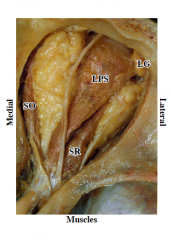
Name muscles shown here.
Hint: superficial eye.
What are their: 1) Functions 2) Innervations
"SALT ME DOWN"
"Recti Return"
"Inferiors Extort" |
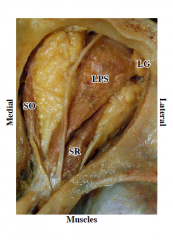
"SALT ME DOWN"
Six ABducts Laterally, Trochlear acts Medially Down. Oculomotor n. does everything else.
I.e.,
CN VI (Abducens) ABducts eye by innervating Lateral rectus.
Trochlear (CN IV) Depresses eye, when its medially ABducted --> innervates Superior Oblique, which: Medially rotates (= Intorts), ABducts, and Depresses eyeball
Oculomotor (CN III) does everything else, i.e.
1) Levator palpebrae superior (sup. layer) -> raise superior eyelid
2) Rectus muscles (R4) - "return" (ADduct) - Superior rectus - ADducts, elevates, intorts - Inferior rectus - ADduct, depress, extort - Medial rectus - ADduct - Lateral rectus - ADduct |
|
|
Which artery is the major supply of the orbit? *Hint: it originates between thyroid and hyoid, in a region of the anterior triangle of the neck.
Name its branches.
Which are superficial and which are deep? |
Internal carotid -> Opthalmic a. -> 1) Superficial (lat -> medial) - Lacrimal - Supra-orbital - Supratrochlear (next to Trochlear n, CN IV)
2) Deep (lat -> medial) - Long ciliary a. ("go aLong to eyeball") - Short ciliary a. ("short-circuits"; goes to ciliary ganglion) - Central a. of the retina** **Only a. for retina -> if cut off, you go blind - Ethmoidal arteries (anterior, posterior) **Ethmoid air cells (=air sinuses) |
|

Name the arteries shown here.
Which major artery do they originate from?
Is this from the superficial or deep eye?
|
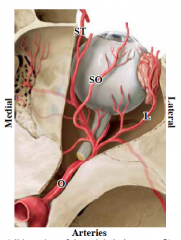
Internal carotid a. -> Opthalmic (O)
Opthalmic a. -> Lacrimal (lateral) -> Supra-orbital (med) -> Supratrochlear (most med; near Trochlear n., CN IV)
Superficial portion |
|
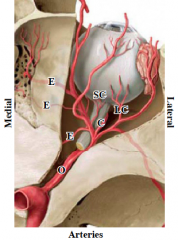
Name the arteries shown here.
Which major artery do they originate from?
Is this from the superficial or deep eye |
DEEP part of eyeball.
Internal carotid a. -> Opthalmic
*Lat -> Med -> Long ciliary (-> "aLong to eyebaLL") -> Short ciliary (-> "short-circuit" to ciliary ganglion) -> Central a. of retina (-> only blood supply to retina; cut off -> blindness) -> Ethmoid a. (ant, posterior) (-> ethmoid air cells (sinuses)
|
|
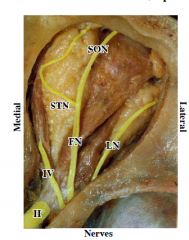
Is this superficial or deep?
Name the nerves shown here.
Which are sensory and which do motor? |
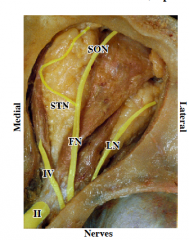
Superficial
CN II = Optic n. (going thru optic canal)
CN IV = Trochlear n. (motor to sup. oblique)
CN V (Trigeminal) -> CN V1 (Opthalmic) ->
**Lat. -> medial
1) Lacrimal n. (LN) - sensory to skin of eyelid 2) Frontal n. (FN) - sensory to scalp, forehead, sup. eyelid -> Supra-orbital (SON; lat.), Supratrochlear (STN; med)
|
|
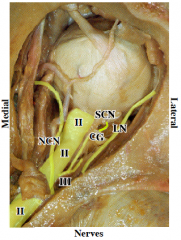
Is this superficial or deep?
Name the nerves shown here.
Which are sensory and which do motor? |
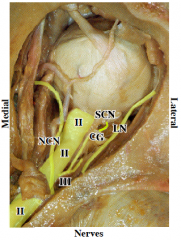
Deep
CN II: Optic CN III: Oculomotor
CN V -> CN V1 (Opthalmic n.) ->
*Superficial branches: Lacrimal, Frontal
**Deep branch: Nasociliary n. (NCN; Sensory to eyeball) -> Infratrochlear (eyelids, nose) -> Ant., post. ethmoid nerves (sensory to ethmoid, nasal region)
|
|
|
Describe the innervation of the Extraocular muscles.
- GSE innervation ("LR6SO4AO3") - GVE innervation (postsynaptic sympathetic) - GA innervation
Is there parasympathetic innervation? |
**NO PARASYMPATHETIC INNERVATION
GSE innervation (-> skeletal muscle of myotome origin)
LR6 - Lateral Rectus = CN VI (Abducens) Sup. oblique - CN IV (Trochlear) All Others - CN III (Oculomotor)
GVE innervation - Postsynaptic sympathetic * Levator palpebrae superioris (smooth muscle part) *Blood vessels supplying extraocular muscles
GA innervation - Proprioception, by CN V |
|
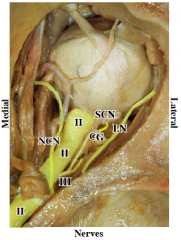
Where is the ciliary ganglion?
|
Ciliary ganglion (CG) - deep orbit, between Optic n. (CN II) and Lacrimal N. (branch of CN V1)
|
|
|
What are the intraocular muscles of the eye?
Which part of the eye is avascular?
Are they smooth or skeletal muscle?
What is their function?
Which are parasympathetic and which are sympathetic? |
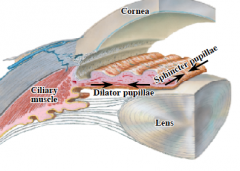
Cornea = avascular
Intraocular muscles - All smooth muscle - Change lens or pupil
Lens - Ciliary muscle Accomodation: Contract -> change lens shape -> focus the eye
Pupil (size)
- Sphincter pupillae (contract* pupil) *Sphincter - "small"
- Dilator pupillae (dilate pupil) **Dilator - "double" (larger size)
Parasympathetic Ciliary m. Sphincter pupillae
Sympathetic Dilator Pupillae "Fight or flight" -> "Eyes widen in fear"
|
|
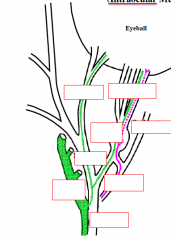
What structure is shown here?
Which nerves provide its fibers?
Does it do somatic or autonomic?
Which nerves are alongside, but not part of it?
|
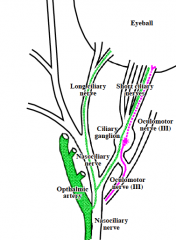
Ciliary ganglion (CG), one of the 4 PSGs (parasymp. ganglia, in head).
Autonomic innervation (has symp., parasymp. fibers).
Nerves:
- Nasociliary (deep branch of CN V1) = sensory
Nasociliary n. (NCN) -> Long ciliary n. (alongside CG; goes aLong to eyeball)
-> Short ciliary n. *Arises from CG *Nerve combo: - NCN - sensory - CN III - parasymp. - Symp. (piggyback on Opthalmic a.)
|
|
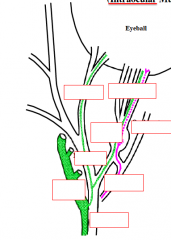
What structure is shown here?
Which nerve gives general afferent (GA) innervation?
For General Visceral Efferent (GVE) innervation: - Nerves for a) Parasympathetic b) Sympathetic
Which intraocular muscles get each? |
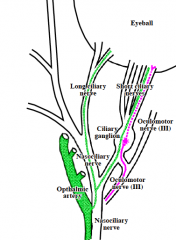
Key for GVE: - Solid purple = presyn. parasymp. - Dotted purple = postsyn. parasymp. - Green = postsyn. sympathetic
Ciliary Ganglion (CG)
GA: Nasociliary n. (= deep branch of CN V1, Opthalmic)
GVE 1) Sympathetic - to Dilator Pupillae - Piggyback on Opthalmic a. AND branches of CN V1 (Long ciliary n., short ciliary n.)
2) Parasympathetic - to Ciliary m. and Sphincter pupillae
- CN III: Presyn. para -> synapse in CG - Post-syn para exits CG to go to eyeball
|
|

What is Horner's Syndrome?
How can you tell which part of the autonomic NS (parasymp vs. symp) is disrupted? |
Horner's syndrome:
1) Interrupt sympathetic innervation to head* *E.g., damage T1-L2 (source of presyn. symp. neurons), sympathetic chain, cervical ganglia
2) Symp. NS -> dilator pupillae muscle, so: - Patient can't dilate their pupil
3) Symptoms* - Ptosis (droopy eyelids) - Miosis (constricted pupil - since can't dilate) *Seen on side contralateral to damaged site - Anhydrosis (decreased sweating) **Sympathetic makes you Sweaty - Flushed skin
*If parasympathetic NS was interrupted, you'd see ptosis too...but NO miosis (since parasymp constricts pupil). Instead you'd see dilated pupil. |
|
|
Which muscles form the Common Tendinous Ring* (CTR)?
*A "Rectus Ring"
What does the CTR divide?
What canal is inside it?
|
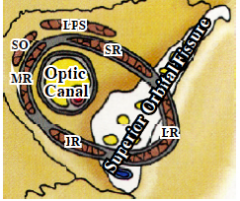
"Rectus Ring" - Sup., Inf, Medial, and Lateral Rectus form the Common Tendinous Ring (= on Apex of Orbit)
CTR divides the Superior Orbital Fissure.
Optic canal is inside. |
|
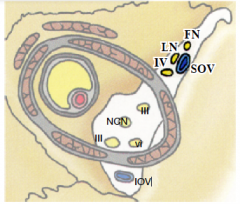
ID this ring.
Which structures are superficial (outside) of it?
Which are deep/inside of it? |
Common tendinous ring, formed from the (4) Rectus muscles.
Superficial structures: - Branches of CN V1: Frontal n. (FN), Lacrimal n. (LN) - CN IV (Trochlear) - Superior opthalmic vein (SO)
Deep - CN III (Oculomotor - Sup., inf. parts) - Nasociliary n. (NCN;branch of CN V1) - CN VI (Abducens) - Inferior Opthalmic v. (IOV) |
|
|
Eye exam
How to test function of
Inf. oblique?
Sup. oblique? |
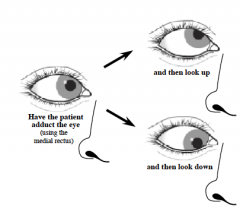
Problem Rectus and Oblique muscles overlap in function: - Sup. rectus, inf. oblique = elevate eyeball - Inf. rectus, sup. oblique = depress eyeball
"Rectus Returns" - Rectus muscles ADduct eye "Oblique is Off to the Side" - Oblique muscles ABduct eye
So to test Oblique function only, have pt ADduct eye (pupil twds nose), and then...
a) Elevate eye (look up) -> Inferior oblique OK
b) Depress eye (look down) -> Superior Oblique OK |
|
|
Eye exam
How to test function of
Sup. rectus?
Inf. rectus? |
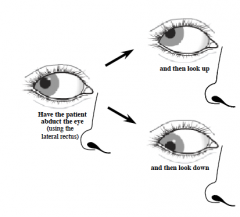
Problem Rectus and Oblique muscles overlap in function: - Sup. rectus, inf. oblique = elevate eyeball - Inf. rectus, sup. oblique = depress eyeball
"Rectus Returns" - Rectus muscles ADduct eye **Except Lateral Rectus!! (ABducts)
"Oblique is Off to the Side" - Oblique muscles ABduct eye
So to test Rectus function only, have pt ABduct eye (pupil twds nose), and then...
a) Elevate eye (look up) -> Sup Rectus OK
b) Depress eye (look down) -> Inf Rectus OK |
|
|
Which TWO muscles are needed to...
1) Look up?
2) Look down? |
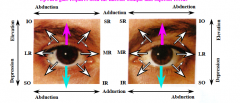
1) Look up = elevation -> Inferior oblique AND Superior rectus
2) Look down = depression -> Superior oblique AND inferior rectus |
|
|
What innervates the lacrimal gland?
How do tears travel from the lacrimal gland?
What is the function of tears? |
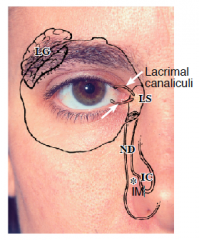
Lacrimal gland = innervated by Facial n. (CN VII).
Path of tears: *Goes lat -> medial
1) Lacrimal gland (makes tears)
2) Lacrimal puncta
3) Lacrimal canaliculi
4) Lacrimal sac (LS)
5) Nasolacrimal Duct (ND) to Inferior Meatus (IM) - nasal cavity
6) Inferior concha (IC; in nasal cavity)
Tears give nutrients and O2 to cornea, which is avascular (i.e., "Tears Take blood's place")
|

